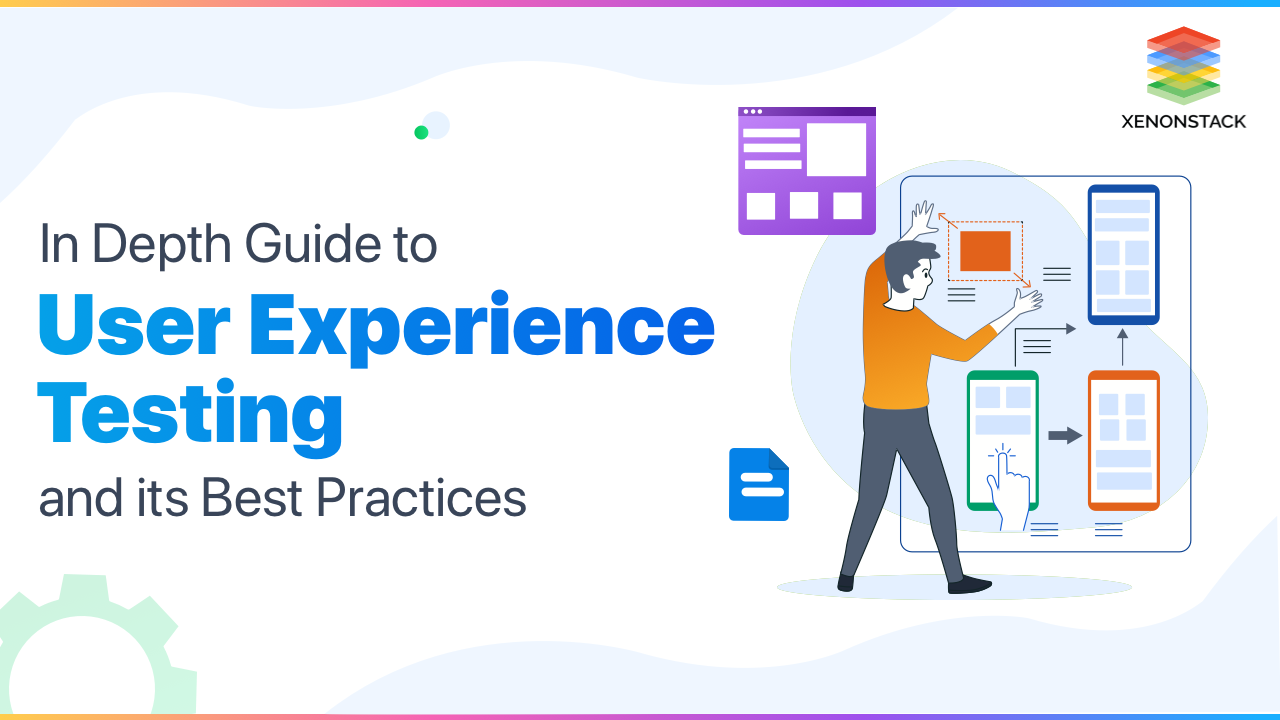
What is user Experience Testing?
User experience testing is having actual people engage with a website, app, or other product you've created and analyzing their behaviours and reactions. It is a vital step to ensure you design an effective, efficient, and delightful experience for your users, whether you start simply by watching session records or go all out and hire a lab with eye-tracking equipment.
The process of creating products that provide meaningful and relevant experiences to users and enhancing user satisfaction/ experience. Click to explore about, What is User Experience Design
It is a way of evaluating a website's, app's, or other digital product's performance by watching real users complete activities on it. Researchers working for a company frequently watch the consumers. Usability testing is used to identify areas of uncertainty and find ways to improve the overall user experience.
- Useful: To determine if your product is valuable in every way possible. The better the user experience, the more beneficial the website is.
- Usable: The programme is simple to use. The user experience is already poor if the programme is complicated to use.
- Desirable: The force and worth of image, identity, brand and other components of emotional design must be balanced against our need for efficiency.
- Findable: Users will discover what they need if we develop navigable websites and locatable things.
- Accessible: Our websites should be accessible to individuals with disabilities in the same way our buildings have elevators and ramps. It's good business now, and it's the right thing to do. It will eventually become law.
- Credible: Websites must be trustworthy; understand the design components that determine whether or not people trust and believe what we say.
- Valuable: Our websites must add value to the lives of those who visit them. For non-profits, the user experience must be supportive of their purpose.
A good user experience allows your customers to quickly and easily find information. Click to explore about, Comparing Customer Experience and User Experience
Why User Experience Testing is Important?
Usability testing done correctly, at the appropriate time, with the right people decreases the chance of developing the incorrect product, saving time, money, and other valuable resources. In other words, if done early on, while the product is still in the paper prototype stage, it detects issues when they are inexpensive and straightforward to solve. When performed on a mature product, it aids in determining a user's success rate and time spent completing a job. There have been hundreds of thousands of instances where usability testing has shown to be a worthwhile investment.
- To check if the product lives up to the user's expectations.
- Business choices are matched to real-world applications.
- Removes the product's defects.
- This feature allows you to see how effective users are in completing their assignments.
- This is useful for gathering user comments and reactions to the product.
How to perform user experience testing
Following steps are performed while performing user experience testing -
- Make a comprehensive plan.
- Prepare your prototype or finished product for testing.
- Find the ideal people to test with.
- Carrying out a usability test
- Thoroughly document the testing.
- Analyze and re-analyze
Make a Comprehensive Plan
Plan the phase of usability testing and analysis. Decide on the structure for assembling your test results based on your objectives. This will enable the process to run more quickly and efficiently.
To acquire clear, succinct, and specific answers from your testing, you must restrict your aims. The scope of your test must then be defined. It might be wide and ask general questions, such as which pages are the most user-friendly or which software function is the most simple to use. It can also ask more specific inquiries, such as preventing users from checking out or preventing conversions.
UX is the most important building block in software development. Even its priority is higher than User Interface. Click to explore about, User Experience in Software Product Development
Prepare your prototype or finished product for testing
Usability testing is frequently carried out throughout the early phases of development. This implies we can't test the final product since we haven't yet. Usability testing is done in the early phases of development to discover obstacles or modifications that would be costly in the later stages. However, we still require the product to do the test. For this reason, most firms create a prototype. It might be a sample app or a website with restricted functionality. However, for the usability testing technique to impact the development, a prototype that is faithful to the vision of the ultimate product is required.
Find the ideal people to test with
The users you hire must connect to the challenges you're attempting to solve. To do this, make certain that no one working on the project is hired as a user. This ensures that users are not prejudiced in favour of or against a certain feature or page.
Carrying out a Usability Test
The actual testing is frequently the most enjoyable aspect of the entire procedure. Make sure the usability test is conducted in a distraction-free environment. Any logistical obstacles, such as a bad connection or recording issues, should be addressed ahead of time. These difficulties should be resolved with a dry run.
Thoroughly document the testing
Compile the findings for analysis once you've completed the tests. Prepare a summary of your findings in one of the predefined forms. Fill up any gaps in your results by listening to the test recordings. This stage will automatically occur throughout the testing process because you have already covered the formats and techniques for the documentation.
Analyze and re-analyze
It's critical to run usability testing regularly if you want to get the most out of the entire process. Usability testing may be simple to set up and integrate into your development cycle if you plan and account for contingencies.
A tool that enables end users, administrators and organizations to gauge and evaluate the performance of a given system. Click to explore about, Performance Monitoring Tools and Management
What are the best tools for User Experience Testing?
The best tools for User Experience Testing are listed below:
Optimizely
The "world's finest experimentation platform," according to Optimizely. It comes with a plethora of tools for conducting experiments, analyzing them, and applying the findings.
It offers a lot of connectors and partners, which is ideal if you already use such products, and you can test everything from marketing materials to product onboarding procedures with it. It's also a fantastic tool for customization.
GTmetrix
You're probably aware that the speed with which a website loads may make or break a conversion. When customers become frustrated with slow-loading pages or modules, they quickly abandon the site.
You may use GTmetrix to measure the speed of your page load and then figure out what's wrong. It will highlight CSS flaws, javascript difficulties, and image compression concerns.
Crazy Egg
Begin by making real-time recordings of your users. Heatmaps show where your users click the most on each page, while scroll maps show you where they stop scrolling. Consider placing a call to action right there. Crazy Egg may also be used for additional reports to aid in the development of the optimal user experience. Running maximum tests and paying attention to the data over time can help you adjust to the changing demands of your consumer base.
Evaluates the usability, functionality, and design of your app by having real users try the app, verifies whether it is user-friendly, and can handle tasks in real-world conditions. Click to explore about, Six Tips for User Acceptance Testing
What is the User Acceptance Criteria?
The requirements that a software product must fulfil to be approved by a user, a customer, or other systems are known as acceptance criteria (AC). They are specific to each user narrative and characterize the feature's functionality from the end-user's perspective. Why define user acceptance criteria why define user acceptance criteria
Why define User Acceptance Criteria?
On its own, a user narrative offers a lot of space for interpretation. The user narrative's desired outcome(s) are clarified using acceptance criteria. It also provides a clear approach for developers and QA to assess whether a narrative is "done."
For various reasons, you should include these standards in your workflow. First and foremost, defining your target objective before development aids in alignment and shared understanding. This knowledge can help you avoid unpleasant shocks in the future.

Conclusion
Usability testing gives a minimal input threshold for the target audience and helps ensure its competitiveness to some level. That is why it is critical to entrust such a critical operation to a team of experts whose primary focus is testing and quality assurance.
- Discover more about User Acceptance Testing
- Learn How to build Recommendation System using AI


